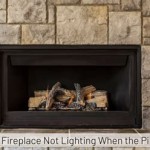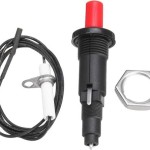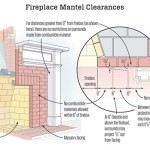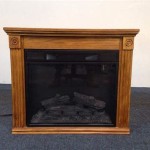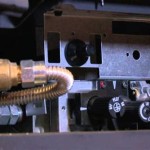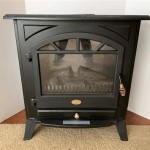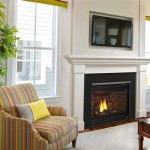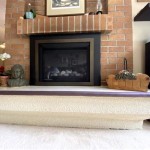How To Install A Gas Fireplace Fan
Installing a gas fireplace fan can enhance the efficiency of a gas fireplace by improving heat circulation within a room. A fan assembly helps to distribute the warm air produced by the fireplace, preventing it from simply rising to the ceiling and allowing it to reach further into the living space. The installation process, while straightforward for those with basic electrical and mechanical skills, requires careful attention to safety guidelines and manufacturer instructions.
Before commencing the installation, it is crucial to determine the compatibility of the fan kit with the specific model of gas fireplace. Not all fan kits are universally compatible, and attempting to install an incompatible kit can lead to malfunction or damage to the fireplace. Consult the fireplace's owner's manual or contact the manufacturer to verify the correct fan kit for the model in question. This step ensures that the fan will fit properly and operate as intended.
Safety is paramount during the installation. The gas supply to the fireplace must be completely shut off before beginning any work. Locate the gas shut-off valve, typically located near the fireplace or in the basement, and turn it to the "off" position. Confirm that the gas is off by attempting to light the pilot light. If the pilot light does not ignite, the gas supply is successfully shut off. Furthermore, disconnect the electrical power to the fireplace at the circuit breaker to prevent any electrical hazards.
Preparing the Fireplace for Fan Installation
Once safety measures are in place, prepare the fireplace for the fan installation. Remove the fireplace grate, decorative logs, or any other components that may obstruct access to the fan compartment. Clean the area where the fan will be installed to remove any dust, debris, or soot that may have accumulated. A clean surface allows for better contact and secure mounting of the fan assembly. Refer to the fireplace's owner's manual for instructions on safely removing and replacing these components.
Examine the designated area for the fan installation. Most gas fireplaces are designed with a specific compartment or mounting points to accommodate a fan kit. Identify these points and ensure they are clean and undamaged. If necessary, use a wire brush or vacuum cleaner to remove any obstructions that could prevent the fan from being properly mounted. Understanding the layout of the fireplace will simplify the installation process and minimize the risk of errors.
Review the instructions included with the fan kit. Familiarize oneself with the components of the kit, the required tools, and the installation steps. These instructions often contain diagrams and illustrations that provide valuable guidance. Understanding the instructions beforehand will streamline the installation process and reduce the likelihood of confusion or mistakes. Gather all necessary tools, such as a screwdriver, pliers, wire stripper, and possibly a drill, to have them readily available.
Installing the Fan Assembly
The installation of the fan assembly typically involves mounting the fan unit within the designated compartment of the fireplace. Align the fan unit with the mounting points and secure it using screws or other fasteners provided in the kit. Ensure the fan is securely mounted to prevent vibrations or noise during operation. Follow the manufacturer's instructions carefully to ensure proper alignment and secure attachment.
Next, connect the electrical wiring for the fan. The fan kit usually includes wiring harnesses and connectors that are designed to integrate with the fireplace's existing electrical system. Identify the appropriate wires for power and ground, and connect them to the fan's wiring harness according to the manufacturer's instructions. Use wire strippers to expose the ends of the wires and securely connect them using wire connectors or crimp terminals. Ensure all connections are tight and properly insulated to prevent short circuits or electrical hazards.
Many fan kits include a thermostat or speed control that allows for adjusting the fan's operation. Mount the thermostat or speed control in a convenient location according to the manufacturer's instructions. Connect the wiring for the thermostat or speed control to the fan's wiring harness, following the wiring diagram provided. Ensure the thermostat or speed control is properly calibrated and functioning correctly before proceeding further.
Testing and Final Adjustments
After completing the installation of the fan assembly, carefully inspect all connections and components to ensure they are secure and properly installed. Double-check all wiring connections, mounting points, and thermostat or speed control settings. Verify that the fan blades are free from obstruction and can rotate without interference. A thorough inspection helps to identify any potential issues before restoring power and gas to the fireplace.
Restore the electrical power to the fireplace by turning on the circuit breaker. Turn the gas supply back on by opening the gas shut-off valve. Light the pilot light according to the fireplace's instructions. Once the pilot light is lit and the fireplace is operating, test the fan to ensure it is functioning correctly. Adjust the thermostat or speed control to test different fan speeds and observe the airflow. Verify that the fan is effectively circulating warm air into the room.
Monitor the fan's operation for any unusual noises, vibrations, or malfunctions. If any issues are detected, immediately turn off the fireplace and disconnect the electrical power. Troubleshoot the problem by reviewing the installation instructions, checking wiring connections, and verifying the fan's alignment. If the issue cannot be resolved, consult a qualified technician for assistance. Regular monitoring ensures the safe and efficient operation of the fireplace fan.
Replace any components that were removed during the installation, such as the fireplace grate, decorative logs, or other accessories. Follow the fireplace's owner's manual for instructions on properly replacing these components. Ensure all components are securely in place and do not obstruct the fan's operation or airflow. The final step ensures that the fireplace is fully functional and aesthetically pleasing.

Fbk 250 Fireplace Blower Kit Installation

Noisy Gas Fireplace Blower Here S How To Replace It Diy

How To Choose And Install A Gas Fireplace Blower Kit

Gas Fireplace Blower Fan Installation

Why Should I Get A Fireplace Blower For My Masonry

Gas Fireplace Blower Fan Installation

Adding The Blower To Jotul Gas Fireplace Project Small House

How Is A Fireplace Blower Kit Wired Fireplaceblowers Com

How To Install Replace A Fireplace Blower Unit

Fireplace Efficiency Blowers And Why You Should Have One
Related Posts

